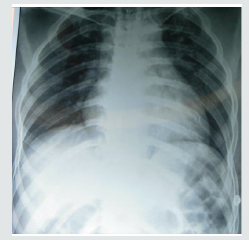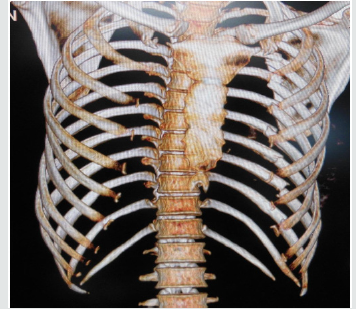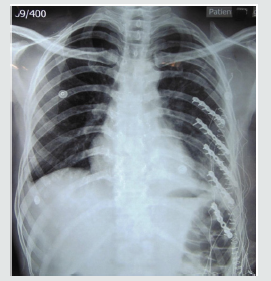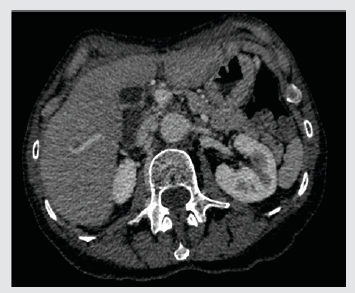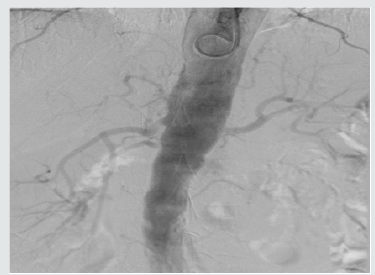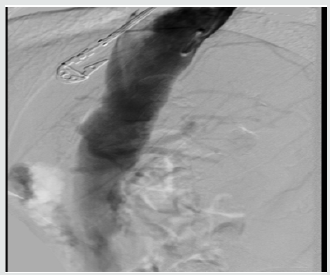Saturday, August 31, 2019
Lupine Publishers: Lupine Publishers | Amaranth - A Functional Food
Lupine Publishers: Lupine Publishers | Amaranth - A Functional Food: Lupine Publishers | Journal of Veterinary Science Abstract Amaranthus, collectively known as amaranth or pigweed, is a cosm...
Friday, August 30, 2019
Lupine Publishers: Lupine Publishers | The Use of Epidural Anaesthesi...
Lupine Publishers: Lupine Publishers | The Use of Epidural Anaesthesi...: Lupine Publishers | Journal of Veterinary Science Abstract General anaesthesia is an essential component of modern me...
Thursday, August 29, 2019
Lupine Publishers: Change of Evaporations Leads to Climate Change
Lupine Publishers: Change of Evaporations Leads to Climate Change: Lupine Publishers- Environmental and Soil Science Short Communication The basis of all floods and droughts is water, its e...
Wednesday, August 28, 2019
Lupine Publishers | Surgical Stabilization of Rib Fractures: Emerging Indications
Lupine Publishers | Journal of Surgery & Case Studies
Introduction: Rib fractures are a common injury after road
traffic accidents. While most simple rib fractures heal well, multiple
rib fractures may result in acute life-threatening complications or
chronic disability and work loss. Though surgical fixation of rib
fractures has most commonly been restricted to multiple rib fractures
with flail chest, there has been a recent interest in fixation of
multiple rib fractures with chest deformity to preclude chronic
disability and loss of work.
Case Report: We report the case of a 34 year male with multiple rib fracture and chest deformity due to multiple, displaced fractures of 3rd to 10th ribs on the left side. He was treated with open reduction and internation fixation of ribs with 2.4mm titanium reconstruction plates and screws. The emerging indications of rib fracture fixation, as seen in this patient, are discussed.
Conclusion: Longer duration of hospital stays and delay in returning to normal life result in poor quality of life and add to direct and indirect treatment expenses. A case-based approach is essential in the decision-making for surgical fixation of multiple displaced rib fractures.
Keywords: Rib Fractures; Fracture Fixation; Chest Deformity
Rib fractures are one of the most common injuries after
road traffic accidents. Most simple rib fractures heal well with
minimum intervention. But multiple rib fractures may require use
of mechanical ventilation and sometimes surgical management
[1]. Thoracic trauma comprises 10-15 % of all trauma and are the
causes of death in 25 % of all fatalities due to trauma [2]. We present
a case of multiple rib fractures and chest deformity and present the
outcome of surgical fixation and its significance.
A 34 year male, a bus conductor, was brought to our hospital in
the emergency room with an alleged history of road traffic accident.
He sustained mild head injury with a history of loss of consciousness
and there were multiple abrasions all over his body. He complained
of severe excruciating pain during breathing and movements of
left arm, with a pain score in VAS scale at 8-9(0-10). Pain was nonresponsive
to analgesics. He had significant depression of the chest
wall on the left side; chest wall movements were equal bilaterally.
Computed tomography of the brain showed no parenchymal injury.
Plain chest radiograph (Figure 1) and computed tomography with
3D reconstruction (Figure 2) demonstrated multiple, displaced
fractures of 3rd to 10th ribs on the left side. There was no evidence of
pneumothorax, hemothorax or lung contusional injury.
There were no signs of pleural tear after fixation, as clinically confirmed by positive pressure ventilation. The wound was closed in layers with a vacuum drain in-situ. He made a rapid recovery with marked reduction in his pain and discomfort (VAS score of 5) on post-operative day 1. The chest wall deformity was fully corrected. He was discharged on the 3rd post-operative day. Patient was last followed-up at 7months. The fractures had united (Figure 5) and recovery was uneventful. He had returned to work 3weeks following surgery.
Incidence of rib fracture reported by various studies ranges
between 7 - 40 %. Most commonly 4th - 9th ribs are fractured.
Fractures of upper ribs (1st & 2nd) usually signify severe trauma with
increased risk of great vessel injuries [2]. Recently there has been a
resurgence of interest in the surgical management of rib fractures
[3,4]. Indications for surgical fixation of rib fractures include flail
chest, severe chest wall deformity, failure to wean from mechanical
ventilation, chronic pain or disability, pulmonary herniation, nonunion
and “on the way out” after thoracotomy [5]. Initial research
suggests that in select patients, operative management of chest
wall injuries is a promising treatment option. Granetzy et al. [4] in
2005 randomised 40 patients who experienced fractures of 3 or
more ribs to receive either conservative or surgical treatment and
the results showed that patients in the surgical group experienced
significantly fewer days on mechanical ventilation, decreased stay
in the Intensive Care Unit and hospital stay and less restrictive
pattern on pulmonary function tests 2 months after treatment [6].
Similar results were found by Nirula et al. [5] in 2006 where they
treated 60 patients with rib fractures [7]. Favourable long term
outcomes of patients undergoing surgical chest wall stabilization
was documented from a prospective study by Lardinois et al. [8],
who had done surgical stabilization of 60 patients of chest wall
injuries from 1990-1999.
Rib fractures have been associated with significant disability and loss of work [9]. Hence selected patients with multiple rib fractures but without flail chest have been hypothesized to benefit better from open reduction with internal fixation than from nonoperative treatment [10,11]. All existing surgical indications are relative. Surgical repair has been attributed to possible sooner return to work and usual activities [5,12]. In a retrospective study by Solberg et al on 16 patients of unilateral rib fracture and chest wall deformity, the overall recovery of the surgically treated patient was much earlier than that of those who were treated conservatively [13]. However, no cohort study is available to confirm the beneficial effects of surgical fixation for multiple rib fractures without flail chest [5,12]. Treatment must be individualized on the basis of the patient’s fracture pattern, overall medical condition, and functional status [12]. This patient presents an ideal scenario where a surgical fixation of the rib fracture would result in better clinical outcomes and reduce the morbidity of prolonged pain and disability and loss of work.
The most preferred modality of treatment of rib fractures is
non-operative, with analgesics and active chest physiotherapy.
However recovery is prolonged or associated with complications,
especially in the presence of multiple rib fracture, floating ribs or a
flail chest. Longer duration of hospital stay and delay in returning
to normal life also result in poor quality of life and add to direct and
indirect treatment expenses. Hence, it is rational to manage certain
patients with multiple rib fracture surgically to reduce morbidy,
mortality and loss of work. Clinical message: The report stresses
the need to make a case-based approach in decision-making and
the need to have a lower threshold for surgical fixation in the
presence of multiple displaced rib fractures. Further cohort studies
are needed to confirm the benefits of internal fixation of multiple
rib fractures in the absence of flail chest.
Abstract
Case Report: We report the case of a 34 year male with multiple rib fracture and chest deformity due to multiple, displaced fractures of 3rd to 10th ribs on the left side. He was treated with open reduction and internation fixation of ribs with 2.4mm titanium reconstruction plates and screws. The emerging indications of rib fracture fixation, as seen in this patient, are discussed.
Conclusion: Longer duration of hospital stays and delay in returning to normal life result in poor quality of life and add to direct and indirect treatment expenses. A case-based approach is essential in the decision-making for surgical fixation of multiple displaced rib fractures.
Keywords: Rib Fractures; Fracture Fixation; Chest Deformity
Introduction
Case Summary
Figure 3: Intraoperative picture demonstrating placement
of 2.4 mm titanium reconstruction plates and screws to fix
the fractures.
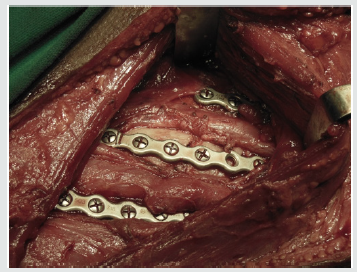
Considering the presence of chest wall deformity and multiple
consecutive rib fractures, surgical stabilization of the ribs was
planned. Under general anesthesia, patient was positioned on left
lateral position, and through a single lazy- S incision starting from
lower border of scapula with a length of 6 cm, lattisimus dorsi
muscle was exposed and split along the fibers and access to the ribs
was made by stripping off the intercostal muscles. The 6th to 10th
ribs were reduced and fixed with 2.4 mm titanium reconstruction
plates and screws (Figures 3 & 4).
There were no signs of pleural tear after fixation, as clinically confirmed by positive pressure ventilation. The wound was closed in layers with a vacuum drain in-situ. He made a rapid recovery with marked reduction in his pain and discomfort (VAS score of 5) on post-operative day 1. The chest wall deformity was fully corrected. He was discharged on the 3rd post-operative day. Patient was last followed-up at 7months. The fractures had united (Figure 5) and recovery was uneventful. He had returned to work 3weeks following surgery.
Figure 5: Anteroposterior chest radiograph at 7 months
following surgery showing fracture consolidation.
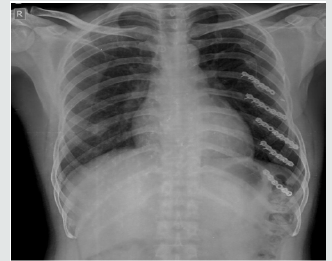

Discussion
Rib fractures have been associated with significant disability and loss of work [9]. Hence selected patients with multiple rib fractures but without flail chest have been hypothesized to benefit better from open reduction with internal fixation than from nonoperative treatment [10,11]. All existing surgical indications are relative. Surgical repair has been attributed to possible sooner return to work and usual activities [5,12]. In a retrospective study by Solberg et al on 16 patients of unilateral rib fracture and chest wall deformity, the overall recovery of the surgically treated patient was much earlier than that of those who were treated conservatively [13]. However, no cohort study is available to confirm the beneficial effects of surgical fixation for multiple rib fractures without flail chest [5,12]. Treatment must be individualized on the basis of the patient’s fracture pattern, overall medical condition, and functional status [12]. This patient presents an ideal scenario where a surgical fixation of the rib fracture would result in better clinical outcomes and reduce the morbidity of prolonged pain and disability and loss of work.
Conclusion
For more Lupine Publishers Open Access Journals Please visit our website:
For more Surgery Journal articles Please Click Here:
To Know More About Open Access Publishers Please Click on Lupine Publishers
Lupine Publishers: Soil Texture of Nesting Sites and Breeding Populat...
Lupine Publishers: Soil Texture of Nesting Sites and Breeding Populat...: Lupine Publishers- Environmental and Soil Science Abstract Investigating the breeding population and soil texture of breeding ...
Tuesday, August 27, 2019
Lupine Publishers: Lupine Publishers| Some Aspects of Red Special Win...
Lupine Publishers: Lupine Publishers| Some Aspects of Red Special Win...: Lupine Publishers- Environmental and Soil Science Abstract Due to increasing environmental radionuclide background, the scien...
Monday, August 26, 2019
Lupine Publishers: Lupine Publishers | Gastrointestinal Parasites Fou...
Lupine Publishers: Lupine Publishers | Gastrointestinal Parasites Fou...: Lupine Publishers | Journal of Veterinary Science Abstract This paper is the first part of a three (3) part series of review...
Saturday, August 24, 2019
Lupine Publishers | Preoperative Parenteral Iron Supplementation in Critical Mesenteric Ischaemia
Lupine Publishders | Journal Of Surgery & Case Studies
Background
Symptomatic mesenteric ischaemia is an uncommon disease entity which
can prove complicated to diagnose and manage. Both
endovascular and open operative approaches have been described but the
nutritional complications caused by poor gut absorption
can mean that these patients may be at higher risk of operative
complications, and appropriate care should be given to preoperative
nutritional optimisation prior to surgical management.
Keywords: Critical Mesenteric Ischaemia; Iron Supplementation; Preoperative Optimisation
Chronic mesenteric ischaemia (CMI) caused by atherosclerotic
stenosis of the arteries supplying the small bowel is a fairly
common finding at autopsy (reported to be between 12-60% of
elderly patients at autopsy [1]), however symptomatic critical
mesenteric ischaemia is rarely reported and can elude diagnosis
for extended periods of time due to the non-specific symptoms of
presentation. Patients may complain of post-prandial abdominal
pain, appetite and weight loss, and “food fear” [2]. In these patients,
as the disease process can be protracted and well-established by
time of diagnosis and management, patients may show signs of
long-term undernourishment, including weight loss, electrolyte
and micronutrient deficiencies and declining overall health [3]. As
such, substantial preoperative optimisation may be required prior
to consideration of operative management and revascularisation.
Consideration should also be given postoperatively to a possibility
of re-feeding syndrome. We present here the case of a 70-yearold
woman seen in our unit with a complex critical mesenteric
ischaemia compounded with general frailty and undernourishment.
A 70-year-old woman was initially referred by her primary care
doctor for assessment of unintentional weight loss for investigation
of possible malignancy. At time of referral, the patient had lost 9
kilograms (from 51kg to 42kg) within 4 months (body mass index
18) and complained of persistent nausea and upper abdominal
pain. She was noted to have a background of rheumatoid arthritis
and chronic obstructive pulmonary disease. A CT scan of the thorax,
abdomen and pelvis did not show any sign of malignant lesions, and
upper gastrointestinal endoscopy revealed only mild gastritis. The
patient was treated with helicobacter pylori eradication therapy
and discharged (Figure 1). She was re-referred to the service
following further concerning weight loss to a body weight of 35kg
with a BMI of 12.86. A repeat upper GI endoscopy was completely
normal. Blood tests showed a mild red cell macrocytosis (MCV 100)
and low ferritin levels; renal function, electrolytes and liver function
tests were unremarkable. Further review of CT imaging revealed an
occluded coeliac trunk with stenosis at the origin of the superior
mesenteric artery and suspicion of post-stenotic aneurysm.
The patient underwent CT angiography which showed critical stenosis with short occlusion of the coeliac trunk origin, and a 3cm occlusion at the origin of the superior mesenteric artery. Bowel was entirely supplied by collateral vessels originating from the inferior mesenteric artery, which was itself also stenosed at its origin. Abdominal aorta, renal arteries and iliac vessels did not show any significant disease. Attempts were made to treat the stenoses with an endovascular approach but were ultimately unsuccessful as it was not possible to identify mesenteric vessel origins due to severity of stenosis. Following this the patient was planned to undergo supracoeliac aortic-SMA bypass, with preoperative optimisation with IV iron supplementation. The patient’s low ferritin levels at diagnosis were supplemented by this approach and came up to normal levels by the time of procedure; this was reflected in the improved full blood count of the patient.” The patient underwent laparotomy and adhesiolysis, following which the root of the SMA was identified (Figures 2 & 3).
ACritical mesenteric ischaemia poses a particular challenge for
preoperative optimization; reduced arterial supply of the small
bowel is likely to affect its function and the degree to which this
occurs is likely to depend on the severity of the stenotic areas.
Equally, preoperative anaemia is known to increase the risk of blood
transfusion, and in turn, increase the morbidity and mortality risk
of undergoing a procedure [4]. A recent study involving patients
with colorectal cancer treated with preoperative intravenous
iron supplementation showed that the haemoglobin level was
significantly increased in the active treatment group, however
the further impact of this increase on risk levels of morbidity
and mortality is not known [5]. In particular, the effectiveness of
this intervention is unknown in patients undergoing high risk
aortic surgery. A 2015 Cochrane report identified 3 prospective
randomised controlled trials investigating its use – two in colorectal
surgery and one gynaecological study. This review suggested that
there was a reduction in use of blood transfusions associated with
preoperative intravenous iron supplementation but it was not
statistically significant. Each of these studies had small patient
numbers, however, and overall the authors note that the studies
are unlikely to have had sufficient power to reliably analyse the
significance of the effect [6].
We present a case of critical mesenteric ischaemia with use
of preoperative intravenous iron supplementation. Intravenous
iron replacement therapy has been noted in the literature to have
reduced the prevalence of preoperative anaemia, though more
studies are needed to see if this truly translates to lower levels of
operative morbidity and mortality, and if this effect is seen across
differing surgical procedures.
Abstract
Background
Symptomatic mesenteric ischaemia is an uncommon disease entity which
can prove complicated to diagnose and manage. Both
endovascular and open operative approaches have been described but the
nutritional complications caused by poor gut absorption
can mean that these patients may be at higher risk of operative
complications, and appropriate care should be given to preoperative
nutritional optimisation prior to surgical management.
Objective
We present a case of critical mesenteric arterial stenosis treated with preoperative intravenous iron supplementation to illustrate preoperative optimisation and therapeutic approaches, together with a selected review of the literature
Conclusion
Preoperative parenteral iron supplementation is likely to be effective in reducing preoperative anaemia but the impact of this intervention on postoperative blood transfusion and other complications in the context of complex aortic surgery is unknown.Keywords: Critical Mesenteric Ischaemia; Iron Supplementation; Preoperative Optimisation
Introduction
Case Report
The patient underwent CT angiography which showed critical stenosis with short occlusion of the coeliac trunk origin, and a 3cm occlusion at the origin of the superior mesenteric artery. Bowel was entirely supplied by collateral vessels originating from the inferior mesenteric artery, which was itself also stenosed at its origin. Abdominal aorta, renal arteries and iliac vessels did not show any significant disease. Attempts were made to treat the stenoses with an endovascular approach but were ultimately unsuccessful as it was not possible to identify mesenteric vessel origins due to severity of stenosis. Following this the patient was planned to undergo supracoeliac aortic-SMA bypass, with preoperative optimisation with IV iron supplementation. The patient’s low ferritin levels at diagnosis were supplemented by this approach and came up to normal levels by the time of procedure; this was reflected in the improved full blood count of the patient.” The patient underwent laparotomy and adhesiolysis, following which the root of the SMA was identified (Figures 2 & 3).
Figure 5: Postoperative CT with 3D reconstruction
showing right renal artery takeoff and vein graft.
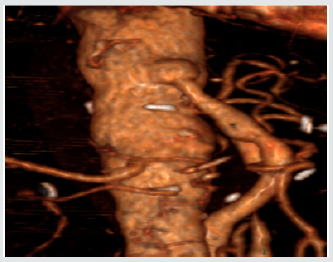
A long saphenous vein graft was harvested and anastamosed to
the supracoeliac aorta proximally and the terminal SMA distally. On
completion of anastamosis and upon opening of the graft, the small
bowel became flushed pink and began enthusiastically peristalsing
almost immediately (Figures 4 & 5). Postoperatively the patient
progressed well, and upon follow up, had gained 7kg in the space
of 3 months. Symptoms of post-prandial pain and nausea, as well
as appetite generally, had improved significantly from her previous
morbid state.
Discussion
Conclusion
For more Lupine Publishers Open Access Journals Please visit our website:
http://www.lupinepublishers.us/
For more Surgery Journal articles Please Click Here:
https://lupinepublishers.com/surgery-case-studies-journal/
http://www.lupinepublishers.us/
For more Surgery Journal articles Please Click Here:
https://lupinepublishers.com/surgery-case-studies-journal/
To Know More About Open Access Publishers Please Click on Lupine Publishers
Lupine Publishers: Lupine Publihsers | The Development Fortified Pan ...
Lupine Publishers: Lupine Publihsers | The Development Fortified Pan ...: Lupine Publishers | Journal of Veterinary Science Abstract The main objective of the research is to develop pan bread nutri...
Friday, August 23, 2019
Lupine Publishers: Lupine Publishers | Use of Dietary Yeast and its P...
Lupine Publishers: Lupine Publishers | Use of Dietary Yeast and its P...: Lupine Publishers | Journal of Veterinary Science Abstract All around the world, sheeps and goats play an important role in ...
Thursday, August 22, 2019
Lupine Publishers: Major Issues Related to Women Health, Social, Cult...
Lupine Publishers: Major Issues Related to Women Health, Social, Cult...: Journal of Gynaecology | Lupine Publishers Abstract Present article sketches out major issues related to health, social...
Wednesday, August 21, 2019
Lupine Publishers: Optimization of Chitosan+Activated Carbon Nanocomp...
Lupine Publishers: Optimization of Chitosan+Activated Carbon Nanocomp...: Journal of Chemical Sciences | Lupine Publishers Abstract First, the minimum energy (geometry optimization DFT-DMol3) i...
Lupine Publishers: Bowels and Urine Odors and Its Solutions | Lupine ...
Lupine Publishers: Bowels and Urine Odors and Its Solutions | Lupine ...: Journal of Diabetes and Obesity | Lupine Publishers Opinion From the beginning time people go for bowel outside in the fi...
Lupine Publishers: Optimization of Chitosan+Activated Carbon Nanocomp...
Lupine Publishers: Optimization of Chitosan+Activated Carbon Nanocomp...: Journal of Chemical Sciences | Lupine Publishers Abstract First, the minimum energy (geometry optimization DFT-DMol3) i...
Tuesday, August 20, 2019
Lupine Publishers: Attitudes of Married Women with Advanced Maternal ...
Lupine Publishers: Attitudes of Married Women with Advanced Maternal ...: Journal of Gynecology | Lupine Publishers Abstract Purpose: In this study, we aimed to evaluate the attitudes of married wom...
Lupine Publishers: Lupine Publishers | Pressure of Climatic Factors o...
Lupine Publishers: Lupine Publishers | Pressure of Climatic Factors o...: Lupine Publishers | Journal of Veterinary Science This research correlates the effect of climatic factors on bluetongue epidemiology in ...
Lupine Publishers: Lupine Publishers | Sicilian Lemon and Honey Light...
Lupine Publishers: Lupine Publishers | Sicilian Lemon and Honey Light...: Lupine Publishers | Journal of Veterinary Science The development of products enriched with physiological components such as pro...
Lupine Publishers: Bowels and Urine Odors and Its Solutions | Lupine ...
Lupine Publishers: Bowels and Urine Odors and Its Solutions | Lupine ...: Journal of Diabetes and Obesity | Lupine Publishers Opinion From the beginning time people go for bowel outside in the fi...
Wednesday, August 14, 2019
Lupine Publishers: Eating Disorders in Developing Countries | Lupine ...
Lupine Publishers: Eating Disorders in Developing Countries | Lupine ...: Open Access Journal of Neurology | Lupine Publishers Editorial Eating disorders, once thought to be a set of rare disea...
Lupine Publishers: Lupine Publishers - Quora
Lupine Publishers: Lupine Publishers - Quora: Lupine Publishers is a premier, peer-reviewed, multidisciplinary, open access, scientific Publisher that aims to publish original work of im...
Tuesday, August 13, 2019
Lupine Publishers: The Physical Study of Vertical Structure of Temper...
Lupine Publishers: The Physical Study of Vertical Structure of Temper...: Journal of Oceanography | Lupine Publishers Abstract Always oceanographers pay attention to layer structure in the sea environme...
Monday, August 12, 2019
Lupine Publishers: Lupine Publishers | Effect of Thermal Stress on Da...
Lupine Publishers: Lupine Publishers | Effect of Thermal Stress on Da...: Lupine Publishers | Journal of Veterinary Science Introduction Thermal stress or heat stress can be defined as th...
Friday, August 9, 2019
Lupine Publishers: Lupine Publishers | Microbial Source Tracking Mark...
Lupine Publishers: Lupine Publishers | Microbial Source Tracking Mark...: Lupine Publishers | Journal of Veterinary Science Microbial source tracking (MST) describes a suite of methods and an investigati...
Thursday, August 8, 2019
Lupine Publishers: Estimating Traffic Volume to Identify the Level of...
Lupine Publishers: Estimating Traffic Volume to Identify the Level of...: Open Journal of Civil Engineering | Lupine Publishers Abstract The increment of vehicles due to the proportional increm...
Wednesday, August 7, 2019
Lupine Publishers: Metals Phytotoxicity Assessment and Phyto Maximum ...
Lupine Publishers: Metals Phytotoxicity Assessment and Phyto Maximum ...: Journal of Chemical Sciences | Lupine Publishers Abstract In this paper, the influence of metals (Cd, Pb, Cu, Co, Ni, Z...
Tuesday, August 6, 2019
Lupine Publishers: Experimenting with New Crops at the Peri-Urban Fri...
Lupine Publishers: Experimenting with New Crops at the Peri-Urban Fri...: Agriculture open access journals | Lupine Publishers Farming at the Peri-Urban Fringe As the world’s human population ...
Monday, August 5, 2019
Lupine Publishers: Lupine Publishers | Molecular Typing Of Capsular P...
Lupine Publishers: Lupine Publishers | Molecular Typing Of Capsular P...: Lupine Publishers | Journal of Veterinary Science Abstract Forty five Staphylococcus aureus isolated from cases of bovin...
Friday, August 2, 2019
Lupine Publishers: Lupine Publishers | Survey on Pathological Lesion ...
Lupine Publishers: Lupine Publishers | Survey on Pathological Lesion ...: Lupine Publishers | Journal of Veterinary Science Abstract A cross-sectional study was conducted from October 2016 to July...
Thursday, August 1, 2019
Lupine Publishers: Study the Corrosion and Corrosion Protection of Br...
Lupine Publishers: Study the Corrosion and Corrosion Protection of Br...: Material science journal | Lupine Publishers Abstract Brass is an important metalloid which is used in construction of ...
Subscribe to:
Posts (Atom)
Gallstone Ileus in the Elderly: Still a Challenge, Report of a Case with Review of the Current Literature
Abstract Introduction: Gallstone ileus is described as an intestinal obstruction caused by luminal gallstone impaction. It is a mainly ...
-
Intellectual Corruption at the APA by James F. Welles in Surgery & Case Studies: Open Access Journal in Lupinepublishers A book...
-
Acute Liver Failure and Thyrotoxicosis Managed with Liver Transplant and Thyroidectomy by Gerardo Tamayo Enriquez in Surgery & Ca...
-
Lupine Publishers | Journal of Surgery & Case Studies Abstract From 1963 to 2019 7,600 ...
